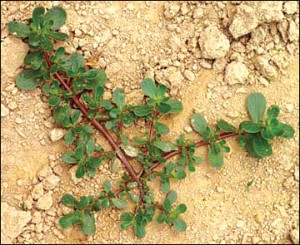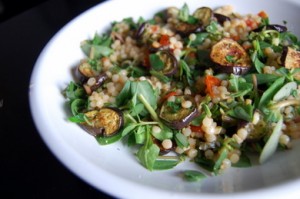The next weed to try out this summer rather than throwing it in the rubbish bin; yes I know we say trash can here in the US but I prefer rubbish; is one that will blow your mind for the nuecence you’ve probably considered it. There are roughly forty varieties currently cultivated around the world; yes I used the world cultivated. It has an extensive Old World distribution extending from North Africa through the Middle East and the Indian Subcontinent to Malaysia and Australasia.The species status in the New World is uncertain: in general, it is considered an exotic weed, however, there is evidence that the species was in Crawford Lake deposits (Ontario) in 1430-89 AD, suggesting that it reached North America in the pre-Columbian era
Purslane is a succulent. A “succulent” is a plant that retains water in the leaves and stems – cacti are succulents. Aloe, jade plants, hens-n-chicks – and, as it turns out, purslane. Purslane looks sort of like bloated thyme, with a reddish stem and small, thick leaves. It has smooth, reddish, mostly prostrate stems and alternate leaves clustered at stem joints and ends. The yellow flowers have five regular parts and are up to 6 mm wide. Depending upon rainfall, the flowers appear at any time during the year. The flowers open singly at the center of the leaf cluster for only a few hours on sunny mornings. Seeds are formed in a tiny pod, which opens when the seeds are mature. Purslane has a taproot with fibrous secondary roots and is able to tolerate poor, compacted soils and drought. Which means this is a wonderful bit of knowledge to have packed away, as in an emergency, regardless of the environmental situation, you can likely rely on these little guys to be hanging around.
Purslane also contains alpha-linolenic acid, one of the highly sought-after Omega-3 fatty acids. Why pay money for fish oil when you can grow your own Omega-3 fatty acids as part of your edible landscaping? Omega-3 fatty acids are instrumental in regulating our metabolism. Purslane contains one of the highest known concentrations of Omega-3 fatty acids — five times the concentration in spinach. Especially when it takes little effort to grow purslane, since it does grow like a weed. Purslane also has stems high in vitamin C.
Although purslane is considered a weed in the United States, it may be eaten as a leaf vegetable. It has a slightly sour and salty taste and is eaten throughout much of Europe, the Middle East, Asia, and Mexico. The stems, leaves and flower buds are all edible. Purslane may be used fresh as a salad, stir-fried, or cooked as spinach is, and because of its mucilaginous quality it also is suitable for soups and stews. Australian Aborigines use the seeds to make seedcakes. Greeks, who call it andrakla (αντράκλα) or glystrida (γλυστρίδα), fry the leaves and the stems with feta cheese, tomato, onion, garlic, oregano, and olive oil, add it in salads, boil it or add to casseroled chicken. In Turkey, besides being used in salads and in baked pastries, it is cooked as a vegetable similar to spinach. In Albania it is called burdullak, and also is used as a vegetable similar to spinach, mostly simmered and served in olive oil dressing, or mixed with other ingredients as a filling for dough layers of byrek. In the south of Portugal (Alentejo), “baldroegas” are used as a soup ingredient.
Give it a shot this summer and let me know what you think. the internet is plastered with recipes for this little succulent weed. As I research and learn more about what is edible around my own yard I become astounded that we have lost so much knowledge in our culture. Share the knowledge and teach you friends and children.
Jon
http://www.wisebread.com/free-food-in-your-yard-edible-weeds
http://en.wikipedia.org/wiki/Portulaca_oleracea




I really like your blog. The articles are great and I appreciate the things I learn. I am going to try this little plant in my salad.
thank you, and thanks for the great info you’ve shared with me; you’ll find bits and pieces spread through out the articles